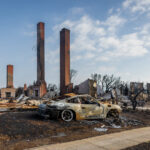Federal officials issued trailers to Hurricane Katrina victims even though some workplace safety tests detected high levels of formaldehyde at government staging areas for the structures just weeks after the storm, a lawyer for hundreds of occupants said March 12.
Documents from the Occupational Safety and Health Administration raise new questions about how much federal officials knew about the units, which were sent to tens of thousands of displaced residents, said attorney Anthony Buzbee. But they don’t say whether the tests in the weeks after the August 2005 storm were conducted inside or outside the trailers.
The Federal Emergency Management Agency, which issued the trailers, has been moving residents out for several months because of health complaints.
Recent tests on hundreds of FEMA trailers and mobile homes in Louisiana and Mississippi found formaldehyde levels about five times what people are exposed to in most modern homes, the U.S. Centers for Disease Control and Prevention announced last month.
At its peak, more than 143,000 trailers were in use by Katrina victims across the Gulf Coast. About 34,000 are still occupied.
Buzbee said he reviewed a 10-page summary of test results from air sampling at FEMA staging facilities in Mississippi that found formaldehyde levels exceeding maximums set for federal workplace safety. Buzbee said the documents show some tests were performed as early as Oct. 11, 2005, and as late as Jan. 17, 2006.
“This is astonishing,” Buzbee said Wednesday in an interview. “How could they feign ignorance that this was an issue even before they sent these trailers to residents?”
It was unclear whether the tests were performed by OSHA or FEMA. Clyde Payne, OSHA area director, said he couldn’t comment on the test results obtained by Buzbee.
FEMA spokesman James McIntyre wouldn’t immediately comment on Buzbee’s allegations, but he said formaldehyde tests at work sites are required under federal law.
“These are just safety tests for personnel,” he said. “They were never designed for the occupants.”
Formaldehyde, a preservative commonly used in construction materials, can cause respiratory problems and is believed to cause cancer.
FEMA lawyers had discouraged officials from investigating residents’ health complaints because of liability concerns, according to documents released by a congressional panel in July 2007.
Buzbee wrote about the test results in a letter to Louisiana Gov. Bobby Jindal and several members of Congress.
Adam Sharp, a spokesman for Sen. Mary Landrieu, D-La., said the information provided by Buzbee will be fodder for a congressional panel’s review of FEMA’s response to formaldehyde concerns.
“One of the essential questions this investigation will answer is, ‘What was the timeline?”‘ Sharp said. “How much of a lag existed between when FEMA became aware of the (formaldehyde) dangers … and when did they first start notifying trailer occupants about the dangers?”
In testimony before a congressional panel last week, a CDC official said problems with formaldehyde in trailers date back to the 1980s.
Howard Frumkin, director of the CDC’s National Center For Environmental Health, said the problem seemed to “recede” until FEMA used tens of thousands of travel trailers to shelter victims of the 2005 storm.
“FEMA has never denied that trailers have formaldehyde,” McIntyre said. “We haven’t tried to hide anything.”
Was this article valuable?
Here are more articles you may enjoy.

 Bankrupt 23andMe’s DNA Data Gets Sale Nod as Concerns Linger
Bankrupt 23andMe’s DNA Data Gets Sale Nod as Concerns Linger  Scammers Are Pushing Auto Loan Fraud to Record Levels
Scammers Are Pushing Auto Loan Fraud to Record Levels  Trump’s Tariffs Threaten to Endanger the Cheap American Car
Trump’s Tariffs Threaten to Endanger the Cheap American Car  Wall Street Brokers Start Trading Insurer Claims From LA Fires
Wall Street Brokers Start Trading Insurer Claims From LA Fires 